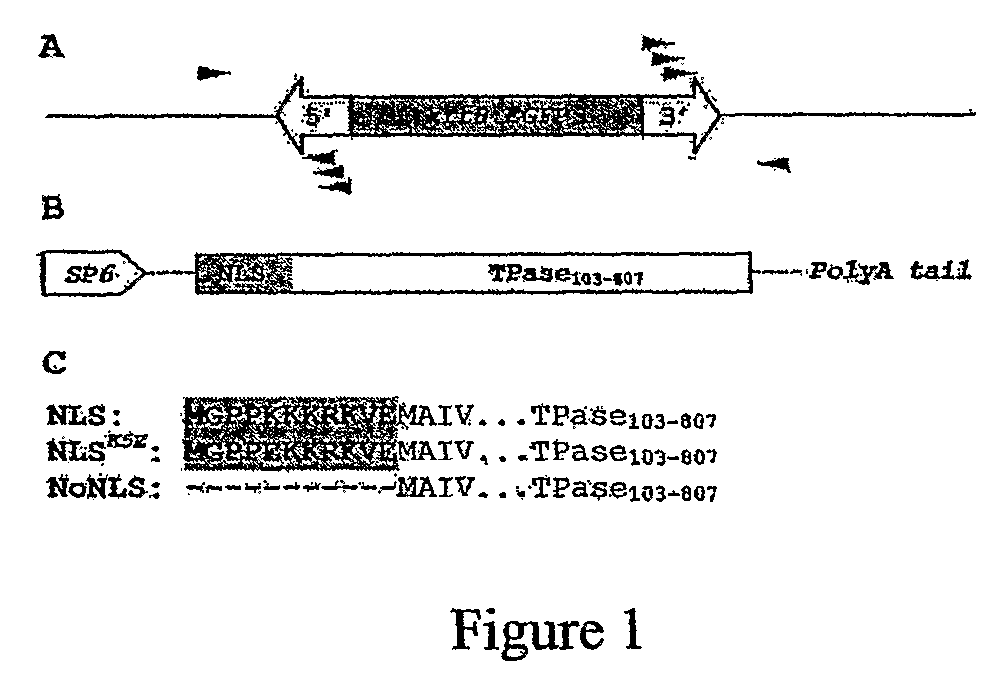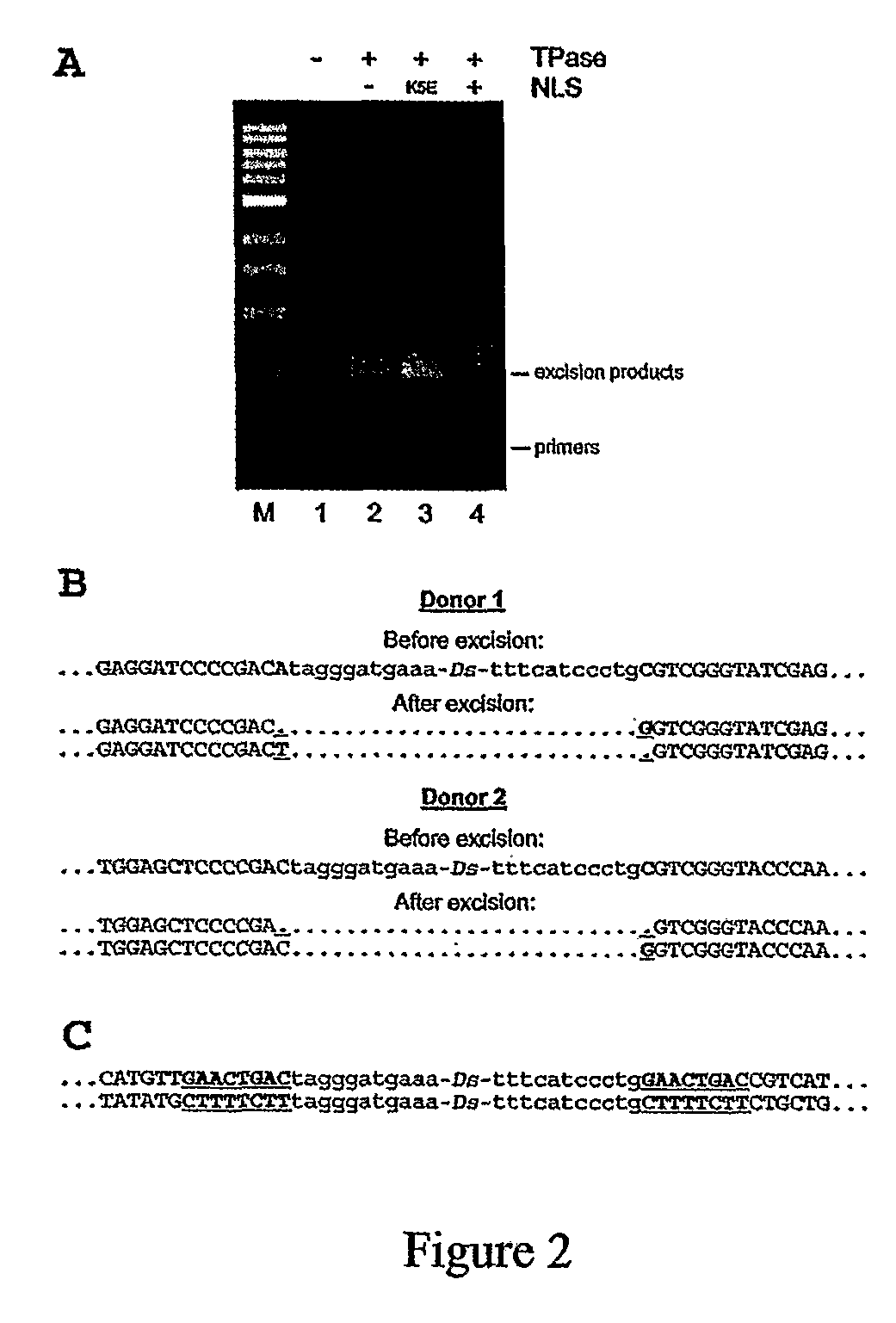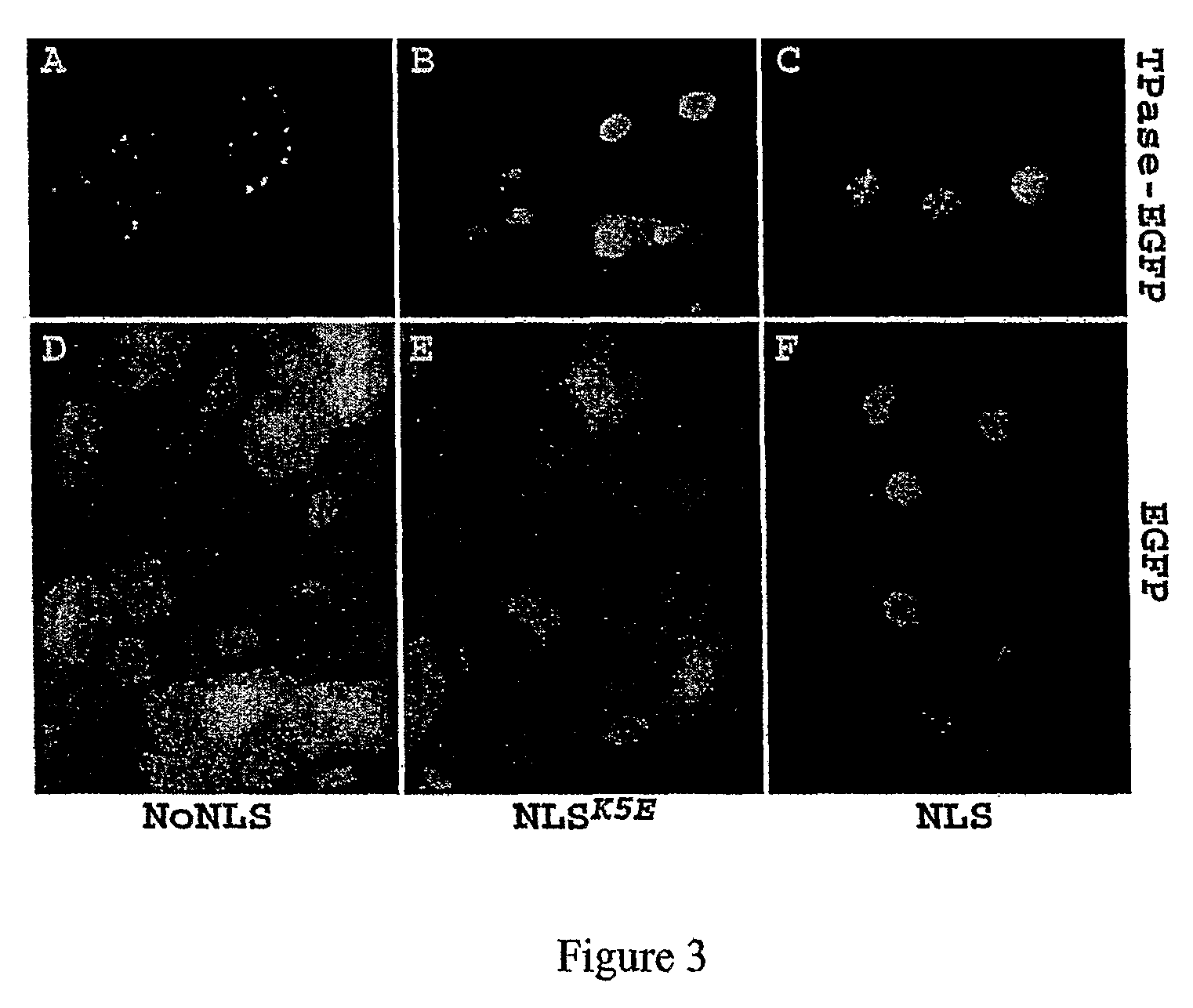Transposition of maize AC/DS elements in vertebrates
a technology of transposable elements and maize, which is applied in the field of vertebrate use of maize ac/ds transposable elements, can solve the problems of zebrafish research that has not been widely used in this capacity, the identification of causative genes disrupted from these mutagenesis, and the identification of enu-derived point mutations requires laborious and slow positional cloning efforts
- Summary
- Abstract
- Description
- Claims
- Application Information
AI Technical Summary
Benefits of technology
Problems solved by technology
Method used
Image
Examples
example 1
Materials and Methods
[0134]Plasmid Constructs
[0135]The construct containing EGFP (Clontech Laboratories, USA) under 2.25 kb promoter of keratin 8 (krt8) gene (GenBank accession number AF440690) was obtained from Dr. Zhiyuan Gong from the National University of Singapore. The 30.1 kb krt8:EGFP fragment was placed into a 0.6 kb miniDs construct (Weil and Kunze, 2000).
[0136]The NLS-TPase cDNA was PCR-amplified using primers “Ac5′-1”: CCAAAGAAG AAGCGTAAGGTAGAAATGGCTATTGTTCATGAACCACA (SEQ ID NO:14) and “Ac3”: GTATCGAT AAGCTTGATATCGAATTCC (SEQ ID NO:15) and pWL80 plasmid (Weil and Kunze, 2000) as a template. The product was used as a template in the secondary PCR using primers “Ac5′-2”: CGCGGATCCGCCACCATGGGTCCTCCAAAGAAGAAGCGTAAGGT AG (SEQ ID NO:16) and “Ac3”: GTATCGATAAGCTTGATATCGAATTCC (SEQ ID NO:17). The product containing nuclear localization sequence (NLS) (MGPPKKKRKVE (SEQ ID NO:2)) fused to a truncated Ac TPase103-807 and Kozak sequence was digested with BamHI and cloned into BglII ...
example 2
Experimental Design
[0148]A two-component system consisting of a donor construct with a non-autonomous Ds element, and a messenger RNA encoding a modified Ac transposase was utilized with an aim to produce Ds insertions in the zebrafish genome. The Ds construct carried EGFP gene under the zebrafish 2.25 kb keratin 8 (kat8) promoter (Gong et al., 2002), confined between 5′- and 3′-end cis-required sequences of miniDs element (Weil and Kunze, 2000) (FIG. 1A). The second construct harbored the coding sequence of a truncated Ac transposase (TPase103-807) (Houba-Herin et al., 19990) fused to an animal-specific synthetic nuclear localization signal (NLS; MGPPKKKRKVE (SEQ ID NO:2)) analogous to that of SV40 large T antigen (FIG. 1B). The gene encoding such a chimeric NLS-TPase103-807 fusion (NLS-TPase) was cloned into the pSP64T plasmid (Krieg and Melton, 1984) containing the SP6 promoter for in vitro transcription. This plasmid also contained the 5′- and 3′-UTRs of the Xenopus β-globin gen...
example 3
Co-Injection of Ds Donor Construct with TPase mRNA Causes Specific Ds Excision
[0155]In vitro transcribed, capped and polyadenylated TPase mRNA was microinjected together with the non-linearized Ds donor plasmid, into zebrafish embryos at the one-cell stage. The embryos were incubated for 10 hours at 28° C. and the genomic DNA was analyzed by excision PCR with primers flanking the Ds sequence (see methods for description). The excision products were detected only in the embryos injected with both the TPase mRNA (NLSK5E-TPase or NoNLS-TPase) and the Ds construct, whereas the control embryos injected with the Ds construct alone produced no PCR fragments of the expected lengths (FIG. 2A). Surprisingly the NLS-TPase failed to produce Ds excision products in contrast to the NLSK5E-TPase that produced the highest yield. The NoNLS-TPase required 5 times more RNA to induce excision at a level similar to the NLSK5E-TPase. Based on these preliminary excision data the NLSK5E-TPase was selected ...
PUM
| Property | Measurement | Unit |
|---|---|---|
| time | aaaaa | aaaaa |
| pH | aaaaa | aaaaa |
| time | aaaaa | aaaaa |
Abstract
Description
Claims
Application Information
 Login to View More
Login to View More - R&D
- Intellectual Property
- Life Sciences
- Materials
- Tech Scout
- Unparalleled Data Quality
- Higher Quality Content
- 60% Fewer Hallucinations
Browse by: Latest US Patents, China's latest patents, Technical Efficacy Thesaurus, Application Domain, Technology Topic, Popular Technical Reports.
© 2025 PatSnap. All rights reserved.Legal|Privacy policy|Modern Slavery Act Transparency Statement|Sitemap|About US| Contact US: help@patsnap.com



